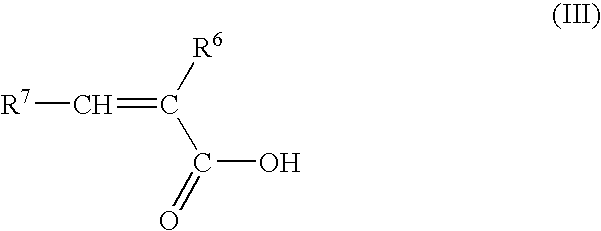Process for the preparation of organosilylated carboxylate monomers, and their use in antifouling coatings
a technology of organosilylated carboxylate and monomer, which is applied in the field of preparation of organosilylated carboxylate monomers and their use in antifouling coatings, can solve the problems of increasing the surface roughness of the whole ship, affecting the performance of the ship, and requiring a long period of working time, so as to achieve excellent antifouling properties, less toxic, and moderate hydrolysis.
- Summary
- Abstract
- Description
- Claims
- Application Information
AI Technical Summary
Benefits of technology
Problems solved by technology
Method used
Image
Examples
example 1
Preparation of trimethylsilyl methacrylate
20 ml of acetoxytrimethylsilane and 11.4 ml of commercial methacrylic acid (ATOFINA Norsocryl® MAA) in 100 ml of hexane are mixed and heated. Azeotropic distillation of acetic acid affords trimethylsilyl methacrylate.
Trimethysilyl methacrylate: 13C NMR: 167.7, 137.6, 127.1, 18.2, −0.257; 29 Si NMR: 24.3; IR (film): 2963, 1703, 1335, 1256, 1178, 874, 854 cm−1.
example 2
Preparation of tri-n-butylsilyl methacrylate
4 g of acetoxytri-n-butylsilane and 1.33 g of commercial methacrylic acid (ATOFINA Norsocryl® MAA) are mixed at room temperature, acetic acid is then distilled under reduced pressure (45° C. / 13 hPa) to afford tri-n-butylsilyl methacrylate.
Tri-n-butylsilyl methacrylate: 13 C NMR: 167.8, 137.9, 126.0, 26.7, 25.5, 18.5, 13.5, 14.0; 29Si NMR: 23.1; IR (film): 2959, 2927, 1703, 1334, 1174, 886, 766 cm−1.
example 3
Preparation of nonamethyl-1-methacryloyloxy-tetrasiloxane
5 g of nonamethyl-1-acetoxy-tetrasiloxane prepared as described in reference example of EP-0839869 and 2.31 g of commercial methacrylic acid (ATOFINA Norsocryl® MAA) are mixed at room temperature. Acetic acid is then distilled under reduced pressure (45° C. / 13 hPa) to afford nonamethyl-1-methacryloyloxy-tetrasiloxane.
Nonamethyl-1-methacryloyloxy-tetrasiloxane: 13C NMR: 166.8, 126.3, 137.8, 18.1, 1.95, 1.24, 1.03, −0.13; 29Si NMR: 7.3, −8.8, −20.1, −21.6; IR (film): 2963, 1730, 1372, 1260, 1083, 1045, 841, 809 cm−1.
PUM
| Property | Measurement | Unit |
|---|---|---|
| boiling point | aaaaa | aaaaa |
| boiling point | aaaaa | aaaaa |
| boiling point | aaaaa | aaaaa |
Abstract
Description
Claims
Application Information
 Login to View More
Login to View More - R&D
- Intellectual Property
- Life Sciences
- Materials
- Tech Scout
- Unparalleled Data Quality
- Higher Quality Content
- 60% Fewer Hallucinations
Browse by: Latest US Patents, China's latest patents, Technical Efficacy Thesaurus, Application Domain, Technology Topic, Popular Technical Reports.
© 2025 PatSnap. All rights reserved.Legal|Privacy policy|Modern Slavery Act Transparency Statement|Sitemap|About US| Contact US: help@patsnap.com



